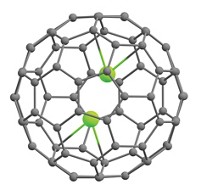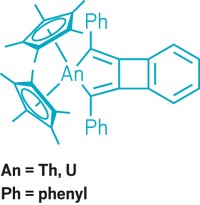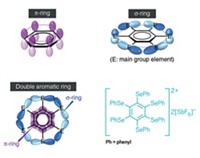Advertisement
Grab your lab coat. Let's get started
Welcome!
Welcome!
Create an account below to get 6 C&EN articles per month, receive newsletters and more - all free.
It seems this is your first time logging in online. Please enter the following information to continue.
As an ACS member you automatically get access to this site. All we need is few more details to create your reading experience.
Not you? Sign in with a different account.
Not you? Sign in with a different account.
ERROR 1
ERROR 1
ERROR 2
ERROR 2
ERROR 2
ERROR 2
ERROR 2
Password and Confirm password must match.
If you have an ACS member number, please enter it here so we can link this account to your membership. (optional)
ERROR 2
ACS values your privacy. By submitting your information, you are gaining access to C&EN and subscribing to our weekly newsletter. We use the information you provide to make your reading experience better, and we will never sell your data to third party members.
Synthesis
δ Aromaticity Spied In Metal Clusters
May 7, 2007
| A version of this story appeared in
Volume 85, Issue 19
Computational studies and gas-phase photoelectron spectroscopy experiments have confirmed the existence of delocalized bonding involving the d atomic orbitals of transition metals. Research on the planar Ta3O3- cluster (shown at left) by Alexander I. Boldyrev of Utah State University, Lai-Sheng Wang of Washington State University, Richland, and coworkers provides the first experimental evidence of a δ-aromatic molecule and suggests that δ aromaticity exists in other planar transition-metal complexes (Angew. Chem. Int. Ed., DOI: 10.1002/anie.200700442). The concept of aromaticity was introduced into organic chemistry to describe delocalized bonding in planar, cyclic, conjugated molecules such as benzene. Aromaticity has since been used to describe bonding in main-group and organometallic compounds, in particular in all-metal clusters. These compounds may exhibit multiple σ and π aromaticity or antiaromaticity involving s, p, or d atomic orbitals. In the case of Ta3O3–, the researchers show that the d orbitals participate in π and δ delocalized bonding (δ molecular orbital at right). The next challenge, the researchers say, is to look for Φ aromaticity, which might occur in metals with f orbitals.





Join the conversation
Contact the reporter
Submit a Letter to the Editor for publication
Engage with us on Twitter